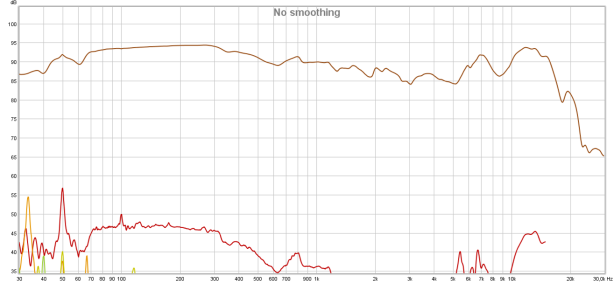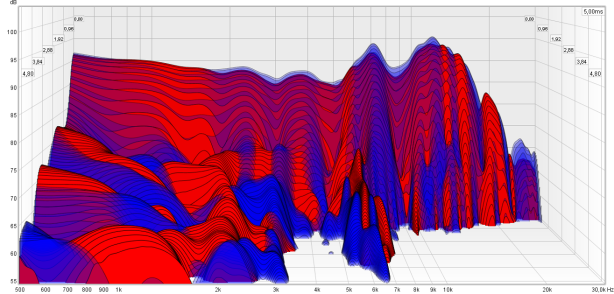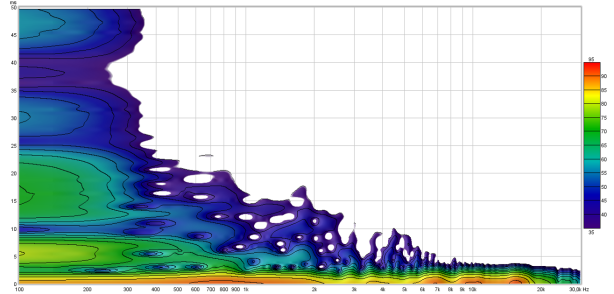Ether Flow
back to MrSpeakers
back to measurements
home
published: Nov-2-2017
NO SMOOTHING is applied to the shown plots. Most measurement sites have some smoothing applied which ‘irons flat’ sharp peaks and ‘wiggles’. I do not use smoothing because some info about sound quality is lost when plots are smoothed.
Aside from a small correction of the microphone itself also some correction in the lowest frequencies is applied to the plots to compensate for the perceived loss of bass when using headphones. This is described HERE in more detail.
A ‘horizontal‘ frequency response curve on the shown frequency response plots on this website thus indicates a perceived ‘flat’ tonal signature.
ALL measurements are made with a good SEAL on a flatbed measurement rig.
The shape of your head, bone structure, pad size, pad ‘softness, (compliance), hair or no hair and or wearing glasses may (drastically) change the frequency response of some headphones, so… your personal experience may differ substantially from these plots.
Frequency response (tonal balance) is the most sound-determining aspect of headphones. A horizontal line shows audible neutral response in the plots on this website. Deviations in different severities at different frequency bands have an effect on the sound character.
The bigger the deviation the stronger the effect.
Below an aid to help determining the sound character of headphones with relation to the frequency response.

MrSpeakers Ether flow
The MrSpeakers Ether Flow is an open orthodynamic over-ear headphone intended to be driven directly from desktop equipment. The low impedance, however, also makes it suitable to drive it directly from portable equipment.
It retails for around € 2000.- which is pretty expensive.
For this you do get a modern looking relatively light-weight and very comfortable headphone. The headband may look flimsy but actually it is not.
Isolation from outside noises is of course not there as it is an open headphone. Others can hear quite well what you are playing.
Not all portable equipment may be fully capable of driving this headphone to louder levels.
specifications:
Type: Over ear, closed
Usage: Home, studio
Driver type: orthodynamic
Pads: replaceable, lamb leather
Inner Pad dimensions: depth = 19mm, height = 60mm, width = 35mm
Collapsible: No
Headphone connector: Hirose connector
Cable entry: double sided
Cable: replaceable, various options when ordering.
Driver size: ø 75mm
Nom. power rating: unknown (assumed 1W)
Max. voltage: 5V (assumed 1W)
Max. current: 200mA (0.2A) (assumed 1W)
Max. S.P.L. 126dB (assumed 1W)
Impedance: 23 Ω
Efficiency: 96 dB @ 1mW
Sensitivity: 112 dB @ 1V
Weight: 390 g.
Clamping force: low/medium
Accessories: DUM cable, clamshell travel case
Sound description:
The Ether Flow open has a ‘warm’ and ‘open’ sound to it. The bass sounds slightly wooly/rubbery. It has a ‘laid back’ character to it and can sound slightly ‘muffled’ in the middle frequencies. Still the overall sound is quite ‘airy’.
With some recordings the sound can have a ‘sharpish accent’ to it.
With ‘busy’ music (a lot of instruments playing at the same time) it is somewhat lacking in ‘dynamics’ and can sound a bit ‘messy’. The low impedance asks for good amplification that can handle low impedances quite well. It can play pretty well directly from portable equipment though.
measurements:
Below the frequency response of the Ether flow (Left, Right)
The frequency response shows a slightly warmish tonal response from 100Hz till 5kHz. Bass as well as sub-bas is there and of high quality albeit a bit on the thin side.
The treble does sound detailed and ‘smooth’ and is not lacking ‘air’ and certainly does not sound rolled-off or limited. There can be a slight ‘sharpish’ tone to some recordings due to the slightly elevated treble. Treble extension is only up to 18kHz and drops of quickly above that point. Pointless to play files with ultrasonic content on this headphone as it simply cannot reproduce it.
The lack of treble extension is absolutely not audible though. The treble is detailed and airy…. It has a slight ethereal character to it. And don’t worry… hires will still sound hires.
The channel balance is exemplary.
Below the distortion measurements of the Ether flow (Right channel).
Note that this headphone was measured at ![]() where background noises were present in the demo room. As this is an open headphone the distortion levels and spectrum plot performance may thus be better in reality than as shown on the plots due to ambient sounds being measured along with the headphone.
where background noises were present in the demo room. As this is an open headphone the distortion levels and spectrum plot performance may thus be better in reality than as shown on the plots due to ambient sounds being measured along with the headphone. Please ignore the spikes around 50Hz and 100Hz. These are actually mains hum present in the portable measurement set-up.
Please ignore the spikes around 50Hz and 100Hz. These are actually mains hum present in the portable measurement set-up.
The distortion levels are low. Below 0.5% in the lows is very good. The peaks around 150Hz are caused by ambient sounds during the measurement.
The 2nd harmonic distortion is most likely lower than the 0.2% shown in the plots. This is due to the limits of the measurement rig which is being reached.
Below the distortion plot but displayed in percentages.
The rise of higher order harmonics between 100Hz and 500Hz could be caused by ambient sounds during the measurement as background noises were present during the measurements.
Below the CSD of the Ether flow . (Left and Right are superimposed)
At 7kHz there is a resonance. Above 8kHz the response is well behaved. Below 3kHz the membrane does not appear to be well damped.
Possibly because of the way the driver membrane is made (my assumption).
Below the CSD of the right channel of the Ether C flow which of course receives more ‘counter-force/damping’ as the rear side and front side of the driver are sealed.
That driver is much better controlled. 
output resistance / damping-factor
As this is an orthodynamic headphone its impedance is as good as ruler flat so a higher output resistance amplifier will have no consequences for the frequency response/tonal balance/damping. So… no plots as it would only show one green line.
Below the spectrum plot of the Ether C flow (Right channel) .
It shows the resonances around 6.5kHz and is less well behaved around 1kHz, 2kHz and 3kHz.
The Ether C flow behaves better as shown below.
The step response (Right channel) below shows the sub-bass extension is not great but still extended just not at the same level as the Ether C.
The higher frequency resonances directly after the initial rise are short lived and decent in amplitude.
Impulse response is almost at the proper level and shows excellent qualities with a only a mild emphasis in the upper mids/lower treble.
The little ripple in the horizontal part consists of the 1,2 and 3kHz resonances and linger on quite long.

summary
Fit and finish, comfort, weight (for an ortho) and build quality are excellent, but is the least we can expect at this price.
The Ether flow looks great and is very, very comfortable.
The sound signature is ‘clean’ and ‘ethereal’. Bass extends deep but is slightly on the lean side. Treble is smooth, realistic and present. Not splashy nor sibilant at all and very detailed but slightly elevated. This gives it a highly detailed impression.
An excellent sounding open headphone.
A cheaper alternative for this headphone is the much cheaper ÆON open.
Build quality and craftsmanship is higher on the Ether of coarse.
There is quite some competition in this price class but the Ether Open certainly is a very good option.

